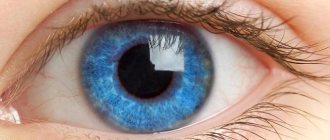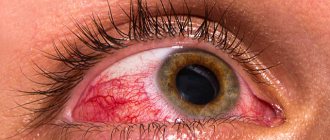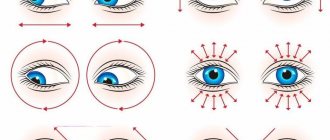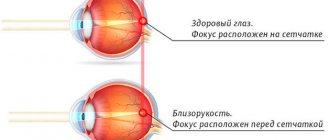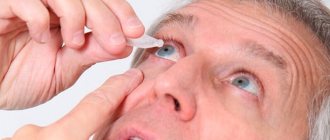Such visual impairment as astigmatism is due to the fact that the eyeball of a sick person is deformed and irregular in shape. The etiology is different: the defect occurs from birth, as a result of surgical interventions or eye injuries.
In addition, taking certain medications causes changes in the properties of the intraocular fluid and, as a result, the shape of the eyeball. The radius of curvature of the cornea in different meridians turns out to be different. Light rays from an object pass through irregular surfaces and become distorted. As a result, the image is partially out of focus. Objects appear crooked or blurry, both vertically and horizontally. When working, your eyes get tired quickly.
The effectiveness of eye exercises for astigmatism
A visual defect, especially in children, is sought to be eliminated before permanent distorted vision develops. To do this, for astigmatism, they resort to glasses with cylindrical or combined glasses and contact lenses.
It is believed that acquired traumatic astigmatism gradually levels out over time, if not completely, then at least partially. It is more difficult to combat drug-induced astigmatism if it is necessary to constantly take certain substances that affect the shape of the cornea.
But in all cases, it is necessary to maintain strength and uniform tension of the oculomotor muscles, which are not only responsible for the movement of the eyeball, but also for its shape. It is very important to prevent visual fatigue, otherwise the accommodative capabilities of the eye are reduced.
To reduce the degree of astigmatism, there are various types of “eye gymnastics”. This kind of exercise increases blood circulation in the eyeball and surrounding tissues, makes muscles stronger, and eliminates fatigue from visual stress.
Benefits of exercise
The main method of treating astigmatism is wearing glasses, which are selected individually for each patient and perform a therapeutic and preventive function to restore vision. In addition, astigmatic disorders have many more methods of treatment and prevention, one of which includes therapeutic exercises.
This article will help you understand how important it is to carry out physical education for the visual organs, what results are obtained from performing gymnastic tasks and how to approach the exercises correctly.
Therapeutic gymnastics for the eyes for astigmatism has quite a lot of functionality, which helps to improve the focusing of vision and the development of a clear vision of objects. In addition, physical education for the eyes promotes:
- improving hematopoiesis of the eye muscles;
- reducing the symptoms of hypermetropic astigmatism - reducing the feeling of eye fatigue, eliminating headaches and eye pain;
- relieving eye strain;
- eye muscle training;
- reduces the likelihood of further vision loss;
- improving metabolism in the organs of vision and nearby parts of the body.
Preparation
Before choosing a set of exercises, you should go to an ophthalmologist and find out if there are any contraindications for such a load. For example, with a developed form of cataract, damage to the cornea, inflammatory and infectious diseases of the organ of vision, exercise for the eyes may not be healthy at all.
Before performing “eye gymnastics,” remember the rule: you should always touch your eyes with clean hands. There is no point in introducing an infection. Therefore, it is worth washing your hands and face. If conditions permit, when washing your face, make several movements with your eyebrows and eyelids, looking in the mirror. This will improve local blood circulation and massage the lacrimal glands and their excretory ducts.
Causes
With astigmatism, the main reason is a change in the shape of the lens or cornea, which causes the light beam to defocus from one point to several. Clinically, this is manifested by “stretching” or distortion of the image, its blurriness.
Various factors can provoke pathology:
- injury to the organs of vision;
- eye surgeries;
- other ophthalmological diseases (keratitis, keratoconus, keratoglobus, ophthalmoplegia, ptosis, dry eye syndrome);
- deficiency of vitamins and minerals (vitaminosis, hypovitaminosis);
- hereditary predisposition.
Palming
Dr. William Bates, an American ophthalmologist, developed an interesting technique for restoring vision by performing exercises and eliminating the mental stress that arises from the effort to see. The doctor gave one of the main exercises of his system the name “palming” (from the English “palm” - palm). With its help, a trained patient can achieve absolute darkness of vision, and this allows the eyes to instantly get rid of harmful tension and relax.
To perform palming:
- Sit up straight, avoid straining your back.
- Relax your face. Close your eyelids.
- Cover your eyeballs with your palms crosswise, with your little fingers touching each other. The middle of the palm, folded in the shape of a bowl, does not touch the closed eyelids. Fingers crossed over eyebrows.
- The eyes are warmed with the palms and relaxed by closing the light.
By covering your eyelids with your palms, you will not immediately see the darkening. It will take some time.
Symptoms and diagnosis of astigmatism
Main symptoms of the disease:
- vagueness and blurriness of the picture, lack of clarity;
- curvature of images - straight lines appear curved;
- splitting of objects during prolonged stress on the visual organs (reading, drawing, watching television, working on a computer);
- difficulty focusing;
- pain in the eyes and eyebrows;
- headache;
- sensations of the presence of sand in the eyes (optional sign);
- increased sensitivity to light (optional);
- rapid eye fatigue;
- There may be difficulties in determining the distance to objects.
How to determine astigmatism? First of all, you need to see an ophthalmologist. The doctor will examine the eye and perform visometry (visual acuity test), after which he will refer you for a diagnostic examination.
Diagnostics may include:
- refractometry, skiascopy - examine refraction;
- computer keratotopography – provides a topographic map of the cornea and determines the degree of the defect;
Basic exercises
The exercise is aimed at strengthening the muscles surrounding the eye. They are believed to be able to influence its shape. This is important for a disease such as astigmatism. Eye movements strengthen muscles and improve accommodation. The main enemy of good vision - tension - is also eliminated through exercise. Local blood supply improves.
Examples of exercises:
- Close your eyes tightly, with some effort (no need to squint). Open wide. Do this 8-10 times, resting for 25-30 seconds.
- Look at the ceiling, then at the floor. Move your gaze to the wall on the right, then on the left. Repeat in a slightly different order: ceiling, floor, left, right. Make sure your head remains still. Do 4 times, resting for 10 seconds.
- Do the exercise. 2, but this time the eyelids must be closed.
- Without moving your body and head, move your gaze upward. Imagine looking at a clock face on the wall and focus on 12 o'clock. Make eye movements at 6 o'clock, then at 12 o'clock. Then in the opposite direction. Do the exercise. 4 times, resting for 20 seconds between sets.
- Ex. 4, but with eyes closed.
Do it while standing. Interval - 1-2 minutes.
Basic Rules
It is important to understand that it is possible to cure pathology with the help of exercises only in the early stages of myopia development; in other cases, gymnastics helps to correct the focus, but for a full recovery additional techniques and therapeutic agents are required.
The basic rules necessary for the full effect of physical education for the eyes with myopia are:
- When doing gymnastics, it is important to relax your entire body to the maximum level - this will allow you to focus your thinking on the correct execution of the task.
- The regularity of training for astigmatism should be 3-4 times a day for 10-15 minutes.
- Before performing physical exercises, it is advisable to consult a specialist who will indicate the correct methodology and help you choose the correct charging mode.
- The exercises should be gradual and smooth to prevent injury to the visual organs.
- The child must be shown how to perform tasks correctly so as not to worsen the treatment process and cause even greater harm.
- Before completing tasks, remove glasses or contact lenses.
- You should take a short break before each task - 20-30 seconds is enough to relax the eye muscles.
- Doing the exercises is strictly contraindicated for persons who have undergone surgical interventions on the visual organs in the last six months.
These rules will help prevent the development of unpleasant symptoms, as well as maintain maximum benefits from therapeutic exercises.
Relieving fatigue and tension from the eyes
It is useful to perform along with basic exercises after sleep and at night, as well as if you experience eye strain during the day.
All exercises are performed while sitting. Examples:
- Close your eyes. After 5 s. open, widening them greatly. Repeat 8 times.
- Blink at a very fast pace for one to two minutes (or do 60 blinks).
- Cover your eyes. Gently massage your eyelids using gentle circular movements with your finger for one minute.
- Cover your eyes. Press, without pressing too hard, the upper eyelid with the pads of two or three fingers. After a couple of seconds, remove your fingers. Repeat 4 times.
Types of astigmatism
Astigmatism is classified according to its origin:
- congenital
- manifests itself immediately after birth and persists in subsequent years; - acquired
- occurs during life as a result of various damage to the lens or cornea.
Depending on concomitant pathologies, astigmatism can be:
- myopic
(shortsighted) – combined with myopia (myopia); - hypermetropic
(farsighted) – accompanied by farsightedness (hypermetropia).
Astigmatism is classified according to location:
- corneal
– caused by pathological changes in the cornea; - lenticular
- provoked by pathologies in the lens.
Depending on the severity of the damage, 3 degrees of the disease are known:
- first (weak)
– less than 3 diopters; - second (medium)
– from 3 to 6 diopters; - third (high)
– over 6 diopters.
Astigmatism is also divided into:
- physiological
(less than 1 diopter) – does not affect visual acuity, is quite often found in newborn babies, and disappears on its own after a while; - pathological
(more than 1 diopter).
Chinese technique
Doctor Shen, who lived in China in the 16th century. n. e., promoted physical therapy for the elderly. The principle is based on a combination of movement and deep concentration of attention on this movement.
To maintain clear vision, he recommended only 4 exercises. They are simple, but they must be performed with the utmost care. Sit up straight, gaze directed into the distance.
Ex. 1: Warm your eyes
Close your eyes. Cover them with your palms, as if protecting yourself from the light. The palms are cup-shaped and do not touch the eyes. The center of each palm is opposite the place where the pupil is located, that is, the center of the eye socket. According to Chinese medicine, there is a point in the middle of the palm called Lao Gong, “refuge after labor.” To find this point, bend all your fingers, Lao Gong will be under the middle pad. In this exercise, Lao Gong must be aligned with the center of the eye socket, then mentally concentrate the thermal energy emanating from the palm at this point. For several minutes you should try to direct the flow of heat into your eyes.
Ex. 2. Rotate your eyes
The eyes are closed again. Make movements with your eyes as if you were describing circles: left, up, right and down. Repeat everything in reverse order. Everything needs to be done smoothly, unhurriedly. Do 8 times in each direction. When finished, do not open your eyes immediately. Wait a little, then rub your eyelids with your fingertips without pressing. Open your eyelids and blink 5-6 times.
Ex. 3. Horizontal eye movements
Extend your right hand forward. The hand is extended and perpendicular to the floor. Fix your gaze on the tip of your middle finger. Slowly move your arm to the right so that it forms one line with your shoulder. Without taking your eyes off the tip of your finger, watch its movement. Do not turn your body or head behind the object. Do a similar movement with the other hand. Do 5 reps.
Ex. 4. Focusing on an object that is coming and going
Stretch your right hand forward, as in exercise 3 described above. Choose one of your fingers and focus your gaze on its nail. Slowly move the brush closer to your nose until the outline of the nail begins to blur. Then slowly move your hand away until your arm reaches an extended position. Repeat 12 times.
The complex is recommended to be done after waking up and before going to bed.
Gymnastics to relieve eye strain
The following workouts are considered the most effective and simple exercises for relieving tense feelings:
- direct their gaze into the distance, after half a minute they focus on an object located in front of them;
- blink rapidly for half a minute;
- close their eyes, rotate their pupils clockwise and counterclockwise (can be done with eyes open);
- raise and lower the pupils, move them left and right;
- close their eyes tightly for about seven seconds, then open their eyes wide;
- smoothly draw a figure eight in the air in different directions with their eyes;
- massage the eyelids in a circle with light movements.
People with a high degree of myopia should consult an eye doctor (ophthalmologist) before practicing such techniques. It is prohibited to practice them for six months after surgery.
To relieve eye tension, you should use other methods:
- Massage of neck and head muscles. It is carried out independently using typical techniques.
- Relaxation. We must learn to relax as much as possible. To do this, lie on your back, close your eyes and imagine something pleasant.
- Folk remedies. Lotions with herbal infusions help a lot.
Read in a separate article: The best eye exercises for glaucoma: gymnastics, massage and exercises
You cannot limit yourself to one exercise; it is important to follow other recommendations of the ophthalmologist. When working at a computer monitor, you must use special glasses that neutralize radiation, and also take a break every 40-60 minutes. Only then can you maintain good vision for a long time and see the world in all its beauty.
Doctors' opinion
Doctors insist, and they are largely right, that eye exercises cannot cure astigmatism and other refractive errors. Official medicine does not recognize the position that the eye muscles are capable of changing the shape of the eyeball. Consequently, exercises aimed at strengthening them do not bring significant positive results. But the statement about the influence of muscles on the formation of the outlines of the eye, as well as the statement about “habitual tension” as the main factor that worsens the refraction of the eye, is the basis of Dr. Bates’ method.
Exercises do not provide such quick and tangible results as glasses, contacts or surgery (if indicated). However, some of the benefits of systematic “eye gymnastics” are not disputed, and its effects are considered deep and natural.
Bates gymnastics
The technique is based on basic yoga and oriental medicine exercises. Official science does not recognize the Bates method, but gymnastics bears fruit and is popular among astigmatists. The exercises should be preceded by palming. Bates argued that only in the complete absence of light can the eye muscles relax as much as possible.
After a few minutes of relaxation, proceed directly to the gymnastics:
- Place an open book or table directly in front of you at a comfortable distance. Try to remember clearly and in detail everything that is depicted there. Then close your eyes and mentally reproduce what you saw.
- Mentally imagine several colors of maximum saturation - red, blue, green, yellow, etc. Each color should be imagined for no longer than one second. The duration of the exercise is 5-10 minutes.
- Plunge into pleasant memories, imagining a picture from the past as clearly as possible. The image should be detailed - this way the brain relaxes and the load on vision is reduced.
- Place Sivtsev’s table in front of you. Look at the largest letter, then imagine the same letter, but darker and smaller. Letters can be changed within one minute, memories are carried out with closed eyes.
IMPORTANT! All sessions take place without glasses or lenses in a well-lit room.
You can learn more about the methodology in the video below:
Development of pathology
In a healthy person, the cornea has a slightly convex shape. The light beam passes through it and through the lens, after which it converges at one point on the retina. At the slightest disturbance in the shape of the cornea, the light stream is refracted in different directions, which is why the retina hits not one point, but several, or the light is focused behind or in front of the retina. As a result, the image becomes distorted and blurry. The greater the convexity of the cornea, the more pronounced the pathology.
A similar picture is observed with lens deformation.
Contraindications
Eye exercises for astigmatism are contraindicated under the following circumstances:
- retinal disinsertion;
- injury or burn;
- high myopia;
- condition after laser treatment;
- infectious and inflammatory diseases of the organ of vision.
If there are contraindications, or if gymnastics leads to deterioration of vision or pain, the exercises should be abandoned.
A combined approach to the treatment of astigmatism provides maximum results. But the most radical and effective treatment is surgery.
Tell us, what methods of eye gymnastics for astigmatism do you know? Share the article on social networks. Be healthy.
Mechanisms of therapeutic action
Hardware techniques are prescribed as a component of complex therapy, combined with surgical interventions, vision correction with lenses or glasses.
Hardware techniques in the case of astigmatism have several types of positive effects:
- improve the metabolism of eye tissues, increasing the oxygen saturation of cells in this area;
- stimulate blood supply to the eyes;
- relieve spasms of accommodation;
- increase the activity of neurons in the visual pathways.
Prevention
Astigmatism is a deviation that cannot be prevented, therefore the very idea of prevention is meaningless. However, preventive actions can help slow the progression of diseases. Prevention consists of observing the following rules:
- The child’s workplace, where he does his homework and does creative work, should be well lit.
- Long breaks between classes are required.
- Therapeutic exercises are useful.
With any non-surgical treatment methods, it is necessary to understand that this is only a way to improve the quality of vision, but not a way to completely eradicate the disease.


